Chapter 12 Rushy Lagoon and Local Stories
But I must not get ahead of myself. Before we were able to tackle the development of Rushy Lagoon with the aid of this wonderful water scheme I had to be able to get possession of the property.
When we heard that Rushy Lagoon was for sale we spent some months in costing the whole project, checking the soil by sampling and testing. We again checked on the contour maps the possibility of putting the water right through Rushy Lagoon by gravitation, because we now knew our tender was the highest and therefore we had literally bought the water scheme, although the formal notification could not be given for another ten days, as per the tendering contract.
We also costed and planned a developmental project which we could immediately undertake if we were the successful tenderer. I approached Westpac Bank and told them I intended to bid for Rushy Lagoon and roughly what I thought it would cost and the potential of the property. They readily agreed for us to buy on overdraft. We then approached the agents and asked them if the company would give us permission in writing to start development immediately we had paid the 10% deposit and before the final settlement was due within sixty days.
They readily agreed to these proposals, so! was able to relax and sleep well the night before the sale, knowing we had thoroughly investigated the project and was again quite relaxed during the bidding.
I usually sit at the back of thc'hall to see who is bidding in front of me, but in this case the main opposition bidder stood against the wall behind me!
I had been to Queensland cattle station sales some couple of years before, when the CSR sold 13 big cattle properties. At the sales one person paid seven and a half million dollars for a property, which was a record price for a cattle station in Queensland.
I thought the bidding was very quick, because they made quarter million bids. This concerned me, with my Scottish blood, to have to bid a quarter of a million dollars each time, and I thought I would try to stop this at the Cascade auction before it started. So, when the auctioneer asked who would start the bidding, I bid 6.4 million and no- one, without their calculators, seemed to be able to add a quarter of a million on each time, so the bidding went up $100,000 at a time.
However, it still continued to go up quite high and I eased Out of the bidding, or made out I had, at eight and a half million, to give the other bidders the idea that I feared it was getting too high.
A syndicate from Queensland had flown over to buy the property and there was a syndicate from Victoria, as well as a private buyer with five sons from Victoria and myself.
By the time we reached eight and a half million there were only two of us left. We kept bidding until we reached ten million, and then the price went up in $50,000 bids. When it reached ten million and 50 thousand I bid 10.1 million and bought it.
Every time I had raised my finger slightly it had cost me $100,000. It was the most expensive finger exercise I had ever done, but we were very thrilled to be able to purchase such a good and big property. Also most other people in the room seemed pleased and excited when we bought it. I think the local bank manager, Rod Woolley gave the staff a drink of champagne!
Our phone rang hot for many days and we had many telegrams and letters of congratulation. I was just amazed and humbled to think that so many people were interested and took the trouble to express their good wishes. These we certainly appreciated.
It was featured in practically all the main newspapers and periodicals of Australia, as it was quoted as the biggest private land purchase in Australia at the time. It was also shown nationally on Four Corners and commercial stations. It really seemed to capture the public imagination, and this enthusiasm and interest still carries on today.
The property was stocked with 50,000 sheep and lambs and about 8,500 head of cattle, so I had to arrange with the auctioneers for us to have the right to begin developing the property straight away.
They agreed to this in writing and so, although I had paid only one million dollars down, or a deposit of 10 per cent, with the rest not payable for two months, I was able to start work next morning with bulldozers, ploughs, tractors and other equipment, and we did a lot of work in the first two months before I really had to pay great interest bills.
We also had to help gather the cattle on the property in conjunc- tion with Cascade and pay for them. I had asked Roberts Stewart's agent to check with the Cascade board. to see whether it would allow me to pay for just the cattle we could yard and tag. As a matter of fact, that was the only way I would bid for the property.
David Archer, after talking to the board, said they agreed, but it was not in writing and afterwards they claimed that they had misunderstood, so, when the final payments were made I had to pay up $70,000 for wild cattle I could not yard. I did not think this was correct and right, and I told them so.
So I think it was a good job I had in writing that I was able to do all this other work, because in their negotiations it was queried by their solicitor. So, as this work had not been finished, I was at liberty to carry on.
The negotiations went on for some five hours and I did not have a solicitor with me. It was quite tough, and probably they were quite genuine when they said they did not understand what the Roberts Stewart's agent was talking about and misunderstood the situation. The chairman and board members were good reliable men, but I was disappointed.
Now, however, that had to be put behind us, for the next thing was to make the property pay and put it in working order. I found that, although it had one of the best shearing sheds in Australia and good sheep yards, there were no water troughs for the sheep. There were also two quite good cattle yards on the property, but there was no water in either of them. I thought this was amazing, and the error was underlined when we were helping round up the cattle and a beast died of exhaustion.
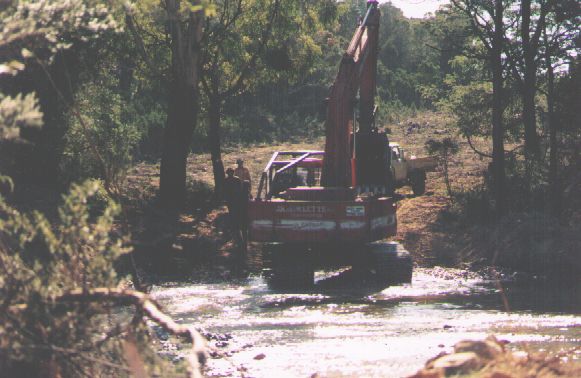
6th March, 1986 - Bridging Ringarooma River for joining up
Wyambi and Rushy Lagoon the day after paying $1 million deposit.
My chaps immediately ordered polythene pipes and three con- crete troughs were sent out, and we put water onto the sheep yards and cattle yards. We also built shelter for the staff when working at the yards and shelter sheds so that sheep drenching could be undertaken out of the rain. We built big footbaths for the sheep and extended the shearing shed to look after freshly shorn sheep. Most of these buildings and extensions were done by transferring buildings not wanted on another part of the property, such as single men's quarters.
We also had to re-gravel and reconstruct some 19 miles (30 kilometres) of roads through the property and build a bridge over the river to connect two properties. By using stones from the adjoining area and using two steel scrap log railway bottoms, it made a good effective summer bridge. In the winter the floods go over the top.
We then began to clear some of the rough areas and replough them. We had a budget to do 2500 acres (1,012 hectares) the first two years, and many people thought that was quite a big project and really impossible to do with all the other work we had on hand.
Two or three of the people who had been in charge before gave in their notice and wished to leave, so we carried on with the younger men from Rushy and our own men, and it probably turned out for the best.
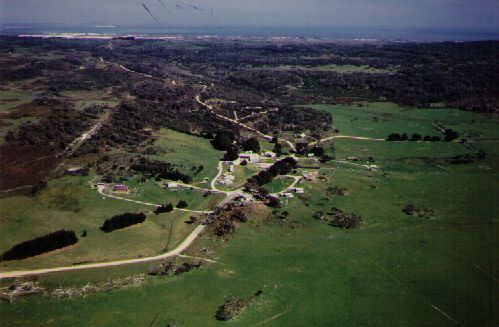
Aerial view of Rushy Lagoon houses, workshops etc.
Ocean in the background.
In the first two years we not only developed 2,500 acres (1,012 hectares) but more than doubled that figure, developing more than 5,000 acres (2,024 hectares) as well as reconditioning other ground. So we exceeded everything we budgeted for in the first two years. After four years we had done a further two thousand acres (eight hundred and nine hectares).
The staff were very keen, and it was obvious they enjoyed being involved in the challenging development. I think it is essential for our staff to become interested and involved in what we are doing, for our success is dependent on their efforts and dedication as well as our own. We had our works programme prepared before we bought Rushy Lagoon, and we discussed it with the staff before we began.
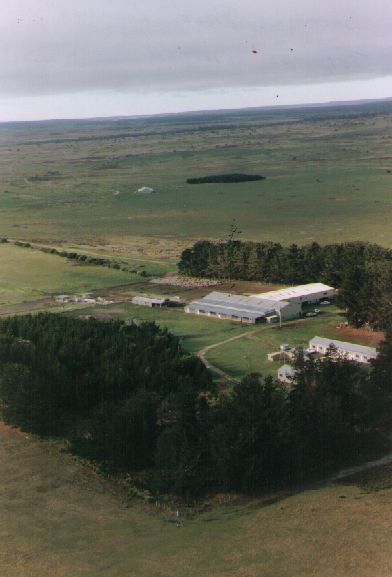
Rushy Lagoon shearing shed and yards.
The programme embraced operations designed for six months, 12 months, two years, and even 10 years. Naturally, this must be subject to discussion and possible alteration, for people involved with a particular job will often find a quicker and more efficient method. It is just impossible to tell everyone exactly what to do.
I think we should promote our own staff wherever possible and not bring in outsiders unless it is necessary. Of course, if a specialist is needed in a specialist field and we do not have such a person with us then we must bring one in. People who are not 100 per cent with you are against you. Our staff are 100 per cent loyal, and that is our greatest strength.
Fences were another problem screaming for attention immedi- ately we took over Rushy Lagoon. The existing fences were in many cases in bad condition; all through the ditches, for instance, they were mostly rotted away. Gates had been put in the centre of the paddocks, and although some had been altered to the corners to facilitate getting cattle out, a lot of them were still in the centre of the fence-lines.
Two or three men can drive a mob of wild cattle from a paddock when they can be run down the fence-line and through the corner gate, but you need two or three times the riders to get them through a gate in the centre of the fence-line. Even then they can break away and you can lose a lot. So rearrangement of the gates in the fences was essential. We put gates in the corner of paddocks. We bought and renewed over 300 gates, used 30,000 droppers for fencing and used 10,000 treated posts for fencing replacements etc. Being able to use timber growing on the property for building and fencing materials was helpful.
The previous owners had put on all fertilisers by air, but we find we can apply it for some $8000 to $9000 per year cheaper without planes, so this is what we do. From when we started developing Wyambi in 1964 to 1988, Cyril Wise and Keith Bennett with their gang, put all the fertiliser and lime on our Wyambi and Rushy Lagoon properties until they sold out to Peter Hall during 1988.
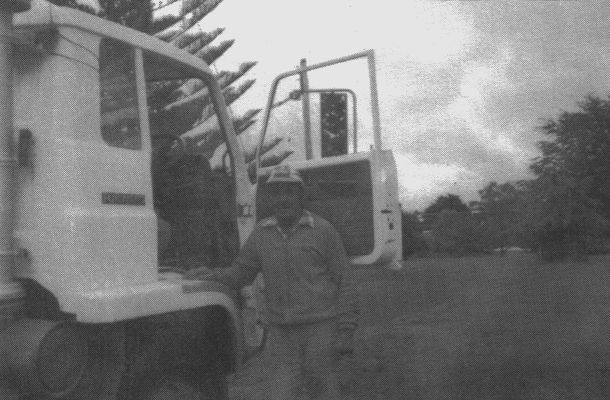
Cyril Wise
In the late 1960's I pulled up Cyril as he was going home one night and asked him how was he going. 'Fine, no problem,' he said. Later when I was going home, George Clayton told me that Cyril had been bogged nineteen times that one day. I said that that was impossible as I had just spoken to him.
However, I rang Cyril up and said it was reported he had been bogged nineteen times that one day. He said, 'Yes, I believe they did keep count, so that would be true.' I replied, 'You said everything was going well and no problems.' He told me that in his business you just expect these little things and they are all in a day's work!
Later Cyril and Keith had good winches and they pulled one another out if they were bogged. However, at that time, 25 years ago, when they were bogged so many times, they had no winches and had to shovel fertiliser from one truck to another. I cannot speak too highly of Cyril and staff; they would not miss any ground and did a terrific job for us and everyone else in the North East for a 25 year period working early and late.
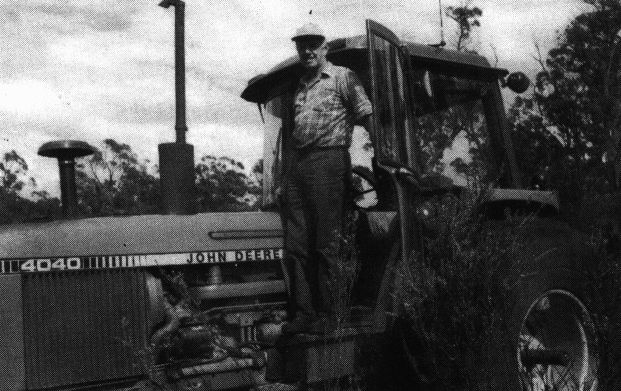
Bob Jensen at work at Wyambi.
Peter Hall and staff are now doing a terrific job also. Peter has a hard act to follow but he is a very capable person (all the Halls are) and he will do a good job.
Bob Jensen is in his twenty-fifth year with us, now mostly improving Rushy Lagoon. Bob works with his equipment by the hour. It makes life so easy when you have such reliable, capable people doing the work. Bob has cultivated and sown down practically all of Wyambi and now large areas of Rushy Lagoon. We also have our own tractors ploughing and cultivating. Bob cultivated some 8,000 acres (3,237 hectares) in one year, counting ploughing, harrowing, drilling etc. - total 8,000 acres (3,237 hectares) by himself!
I remember Bill Lester was mixing grass and clover seed at Wyambi and asked Bob how many acres he wished mixed per day. Bob said, 'Just mix 60 acres (24 hectares) per day andin my spare time I will go harrowing.' Bill said to me, 'That man could not drill that many acres per day; he must be joking.'
Bill said he mixed more grass and clover seed in one week than he had done previously in 40 years on his Winnaleah property!
It is fifty years since Bob started work with Ron and myself at West Scottsdale. After Ron was drowned on his Winnaleah property on Christmas Eve in 1965, Bob did private contract work, but as mentioned he has been with me now for twenty-five years. Unfortu- nately Bob was in hospital having a very bad spin. He is now home again and making good progress. He does not give up easily.
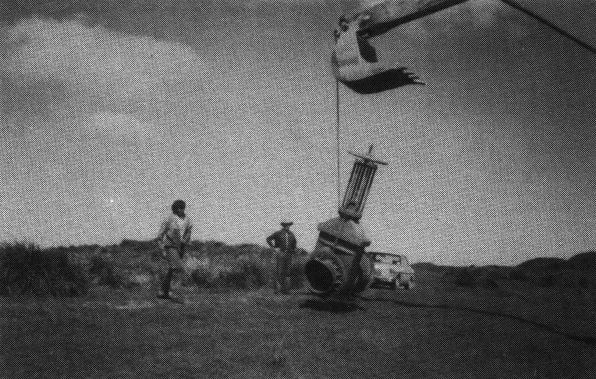
Rodney Moore and I watching installation
of valve on first weir constructed on
Rushy Lagoon in 1986.
When we purchased Rushy Lagoon a lot of the big ditches, some six to eight feet (1.8 to 2.4 metres) deep, had no crossings apart from probably some in the centre of the paddocks where a gravel road crossed, and when cattle were driven down a fence-line they had to go through these deep ditches, which in winter were full of water. I understand that quite a lot of cattle were drowned, and one of the men told us they lost 30 or 40 sheep in one instance.
So we bought a big mile-long (1.6 kilometre) 45-inch (1143 millimetre) diameter steel pipe column and put in some 250 crossings, a lot of them on the fence-lines. We put one on every fence-line so cattle and sheep could be driven down it and over the crossing. This also made the fencing a lot easier, as it went over the top of the pipe crossing on each side of the fence.
When we put the water through Rushy later on we used these same pipe culverts for weirs. On them we put a sliding shutter gate with a contraption which would lift the gate shutters on the front of the pipe up and down on a steel frame inlaid with rubber. We designed this ourselves, and it is very efficient.
I understand that British Tobacco, when they owned the prop- erty, thought of putting one weir near their boundary, but it was a costly project and they did not go on with it. We have installed some 24 weirs and ditches and waterways during the past two and a half years since we bought Rushy, or 24 times more than they budgeted to do.
But to get back to our big water scheme; to divert it through the centre of Rushy Lagoon was a major job. As mentioned Rodney Moore, David Probert and I did most of the surveying, except through a steep bank, which Max Giblin, of the Rivers and Waters Commission, surveyed, and the Commnission were very helpful when we rang up and discussed the project with them.
We diverted running water in the direction of the shearing shed and towards the Musselroe River and the other main channel went right out into the Little Musselroe River and Little Musselroe Bay. (See irrigation map at back of book.)
Then we cleaned out the big channel for some 33 miles (53 kilometres). The western extension to the Mt. Cameron water race had actually gone through part of Rushy for years, but it was on the low-lying ground and extended to their lease area down to the big old McGregor Dam.
We cleaned out this 14 mile (22 kilometre) race, which had not been cleaned for 38-odd years, and we put valves in the McGregor Dam, which is not very deep and covered about 30 acres (12 hectares). We extended the race for about another four or four and a half miles (six or seven kilometres) so that we could use water from the McGregor Dam for the summer period.
Initially the big problem was to cross a hill to get into Rushy Lagoon proper. This necessitated a cut 27 feet (8.2 metres) deep through the hill. Some 13 feet (4 metres) of this was stone, so it was a mammoth job, and we had a little fretting in the walls of the cut, having to push it right back on either side. I suppose the filling from the cut and all was about 109 yards (100 metres) wide, and we had to push a third of it back.
One American visitor who had a look at our work remarked,
This may be another thing we will be able to see from the moon!
The Great Wall of China is one of the few landmarks that can be seen
from outer space, so, although it was a frivolous remark, it was quite
a compliment. It certainly was quite a big job.
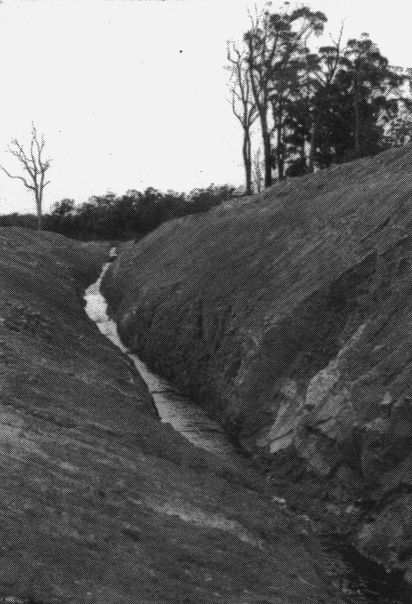
27 foot (8.2 metre) deep rock and dirt cur constructed
by me in 1986 for extension of the water race by a further
30 miles (48 kilometres) throughout Rushy Lagoon.
And then, to extend it right through Rushy Lagoon on a gravitation basis was, as the Director of Mines, said, a major engineering feat, which we accomplished quite successfully.
We crossed two pinnacles, crossed the road two or three times, and in two places we had to lay two 18-inch (457 millimetre) pipes side by side, because we did not want to deepen the race, as then we would not be able to get over the far bank without a deeper cutting for some distance, probably 6 or 8 miles (10 or 12 kilometres).
Ernest Mills, who used to own the property, said he was amazed we were able to get the water through by gravitation. Over one gully we crossed, the race would have had to go up in the air, for we could not drop into it, so it was a matter of deciding whether to put pipes across or whether to build a dam in the gully and keep it full. We came to the conclusion that we could build a dam for the same price as for putting pipes across, and there was an added advantage in that it would provide a drinking area for watering stock.
So we put a valve in the bottom of the dam, from which we could irrigate if we had a break in the race or wanted to add surplus water down the stream for use on the southern side of the race. We believed we could open the valve and let water go across the big flats where we had already put weirs in to hold the water table up to keep the pasture green.
The big thing about weirs on the big flats is that they hold the water level higher, whereas drains draw all the water out and allow it to disappear in the summertime. If the water can be prevented from draining out of the channels, which are kept full of water, it can be used to advantage when, during a prolonged drought, the flats start to dry out. It will also take a lot longer for the flats to dry out if you have the main channel full of water right through the centre of the property. The side channels also fill with water, because there are some thousands of acres with very little fall.
It is a wonderful method of irrigating underneath if you can keep the water table up. It is better than flooding on top - better for the sheep and better for the plants, whose roots go further down. This is a very simple and effective method, and easy to operate.
During a visit to our property by agricultural students from Scotch Oakburn College in Launceston, I asked them if they would like to see one of our weirs. They said they would. 'But,' I said, 'if you want to see a sophisticated concrete weir of huge proportions you will be disappointed. If, however, you want to see a very cheaply constructed but efficient weir you will be impressed.'
It just depends on what you want to see. So many people are not impressed by effective, simple things; they have to see some great structure, and then they are impressed.
Unfortunately, today a lot of our engineers like to build expensive construction projects, which are probably uneconomical to work, whereas I believe our water scheme will probably carry on for a long time. The Mt. Cameron water race has been going for a 100 odd years, and I think it will go for another 100 years and more.
The Big Chum Dam, which is the big storage complex for this scheme, is bigger, according to the Mines Department, than the Cascade Dam, which supplies Winnaleah with water. And bear in mind that we increased the head and width of the dam, which made it about one-third bigger still. This makes it a very big dam indeed. The scheme takes up water from the Musselroe River and the Musselroe Creek and then is supplemented by the Big Chum Dam - then it enters our property, running along high ground which makes it ideal for irrigation. On top of the hill we made use of the big Star Mine which is about 30 to 40 acres (12 to 16 hectares) in extent and up to 30 feet (9.1 metres) deep.
Before we filled in all the outlets with a bulldozer and excavator we put in pipes and a valve on one outlet which was 30 feet (9.1 metres) deep, the other outlet was about 24 feet (7.3 metres) deep and we put another set of pipes and valve there. This helps top up the race and take up any evaporation and seepage in its length before it enters the main property, where we use it to advantage.
Where the water runs through our property we do not generally worry about seepage, because it helps keep the water table up and keep things green.
With doing all these big projects, including new areas of pasture, the giant water scheme undertaken, it was a shock to us during the first year to have Richardson's Meat Industries (meat processor) go bankrupt owing us nearly $250,000. Eventually (after two years) we did get the money owing to us, but we are now approximately $140,000 out in compound interest payments.
Many people were aware of the big projects we had undertaken, and knew that we had exceeded all targets with regard to production and development; most have been helpful and encouraging.
It is a big property and any section of it would be a payable proposition now with the plentiful supply of water through the property. It makes possible to conduct many farming operations such as dairying, potato and vegetables, oil crops, poppies, pyrethrum production and so on.
The size would be equal to 137 fanns of 500 acres (202 hectares) which is bigger than the average-sized northern Tasmania property.
James McAuley's poem about 'Rushy Lagoon' taken from 'My Country Australian Poetry and Short Stories,' really sets out in verse the operations and the sites and scenes of Rushy Lagoon.
At Rushy Lagoon
Wet mirrors covering soft peat.
Swag-bellied graceful mares in foal.
Red-umber bulls on plashing feet
With mild white face and curly poll.Crutching time; each heavy ewe
Is trimmed and slides off down the chute.
The mountains are cut out in blue.
An opalescent sky is mute.Ducks loiter. Children play before tea.
In the home paddock a lone goose
Follows the cows for company.
It is a world of sense and use.James McAuley 1917 - 1976
Recently I met one of the consortium of buyers from Victoria who bid at the public auction for Rushy Lagoon in 1986, and I asked him why they did not keep bidding. Why did they stop at $8.5 million? He replied that the soil, climate and everything else was right, but there was no water through the centre of the property. He added that he did not understand the water availability and potential of the old Mt. Cameron water race.
Two separate potential buyers claimed it was better that I had been successful in the purchase. They were quite complimentary and said that no-one else in Australia could have or would have undertaken the big water schemes that we have completed.
When we look back we can be proud of our achievement. At Wyambi and Rushy Lagoon we now have under our control 11 major dams, the smallest of which holds about 15 million gallons (67.5 megalitres); we have built nine of these dams and enlarged the two existing dams which alone cover more than 100 acres (40.4 hectares).
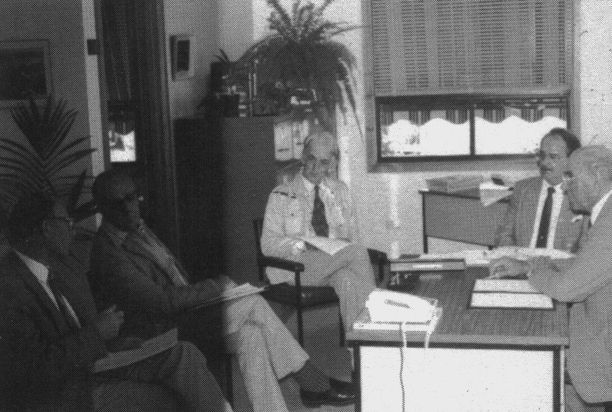
First meeting of the Reconstituted Mt. Cameron Water Race Board in our Scottsdale office.
The meeting took place on December 1st, 1987 (100 years after the Board was first formed)
following the taking over of water races, some of which were already operating in 1887.
From right: Chairman - Hugh Murchie, Secretary - Peter Allan, Board Members - Bert
Farquhar and Terry Green, Rivers and Water Supply Commission observer Reg Barling
We have built 24 weirs and have more than 108 miles (174 kilometres) of races, without one pump in the entire complex. The total water storage is about one billion gallons, or about 4546 megalitres, or approximately 3788 acre feet, and as well, there is a constant supply from the Musselroe River and other sources.
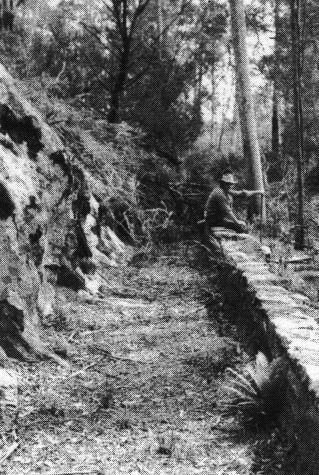
Part of Mt. Cameron Water Race intake
being cleaned up and ready for water
supply.
Note 100 year old stone work 1887-1987
As mentioned I suppose the water schemes, including supply rights, dams, weirs, syphons, channels etc. could not be built today for less than $10 M. Actually to get the water rights, plus construction through State Forest etc. at present would be almost impossible.
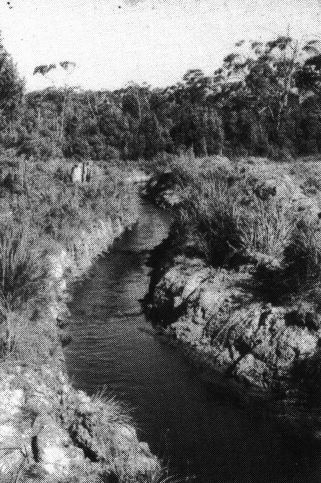
Part of 100 year old water race
cleaned out and water flowing.
I will give a simple detailed 'run down' of how the Mt. Cameron, Miegunyah, Rock Bank and Rushy Lagoon water scheme operates. As mentioned the Mt. Cameron Water Race Authority started operation over 100 years ago. Today in 1990 the race intake is in beautiful country towards the headwaters of the Musselroe River. The intake was paved and concreted by the early mining pioneers.
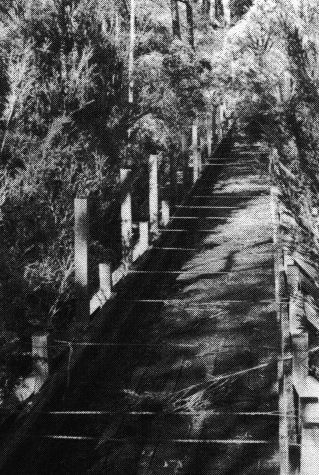
Chum Creek old wooden fluming still operating.
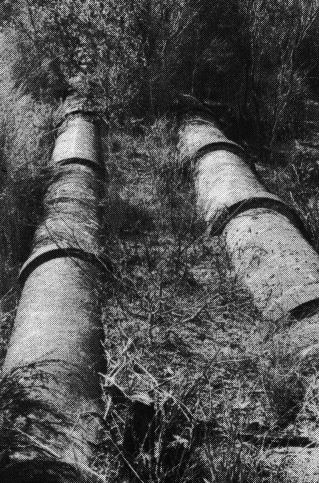
Close-up of part of our concrete syphon
taking gravitation water from one hill
over a gully to next hill.
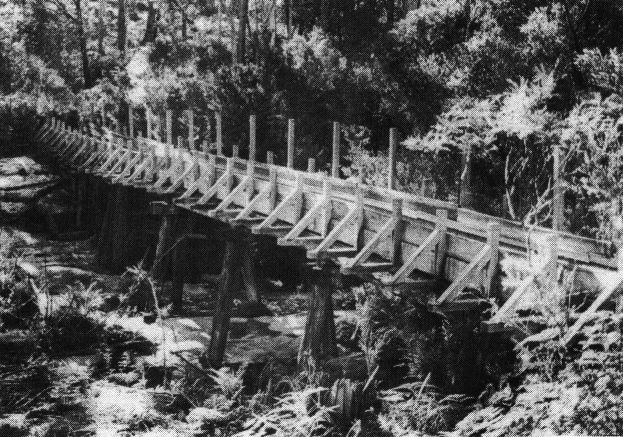
Fluming over a gully near the Qium Dam.
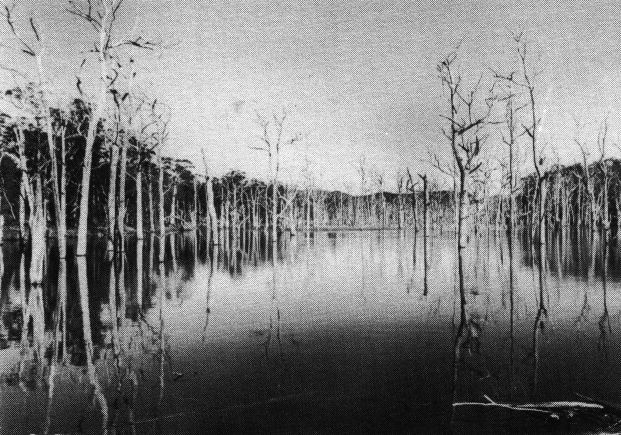
Chum Dam - 75 acre (30 hectare) 30 feet (9.1 metre) deep
Chum Dam that I enlarged in 1986 to supplement water supply.
Forestry Commission intends to retrieve all these
dead trees from the dam when empty in the early 1990's.
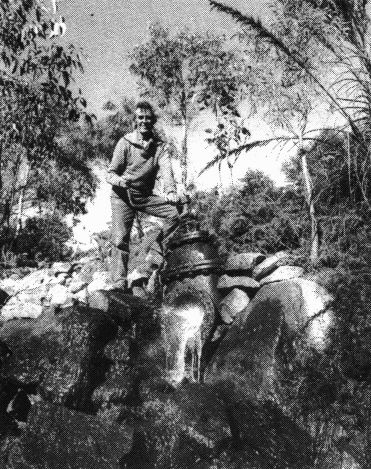
Reg Moore turning on one of the two valves on the big Chum Dam.
The earthen water race containing sections of fluming continues northwards towards Miegunyah. (This is really part of Rushy Lagoon, so I will refer to the joint areas in future as Rushy Lagoon.) This continues through Crown Land, for a length of about 13 miles (21 kilometres) to a position opposite the big Chum Dam. Along this 13 miles (21 kilometres) it picks up the Musselroe Creek and then it can be supplemented by the Chum Dam.
As it gravitates around the gullies and hills, some of it virgin bush, it is transferred from one hill to another hill by a syphon, then enters our property where it is further supplemented if necessary by the Star Mine Dam. It then crosses the Brown's Bridge road to the main area of the Rushy Lagoon complex.
At this stage the race has a fall of about 1 in 600, that is 1 foot fall in 600 feet or 1 metre in 600 metres. After it enters the north side of the road, the race is delivering about 11,000,000 gallons (50,006,990 litres) of water daily and the race branches north and west. The newly- constructed northern section, which we built, extends mainly towards Little Mussleroe Bay and the other section extends westwards.
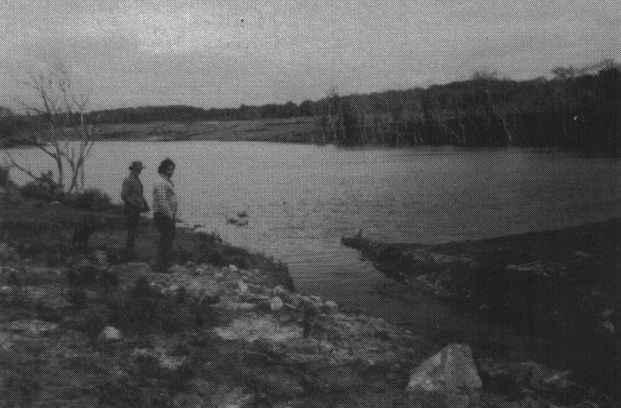
Top Musselroe Dam built in 1988.
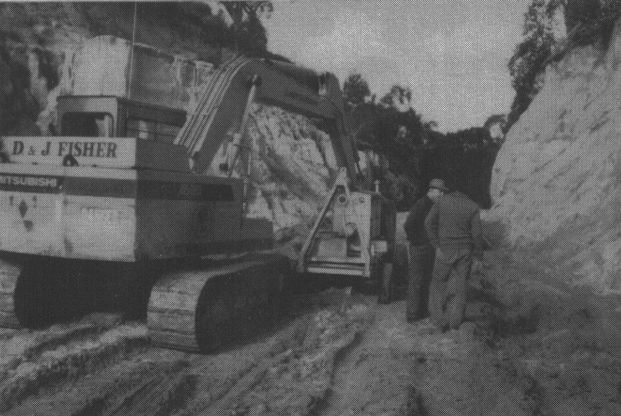
1988 - Installation of valve and closing outlets at Star Hill Mine.
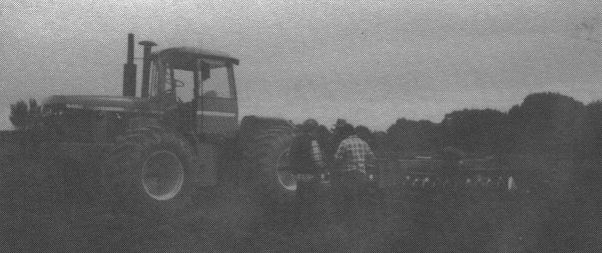
1987 - Developing of new ground at Rushy Lagoon. Darrell Wing's equipment.
Existing trees left for shelter.
The newly-constructed section, fall 1 in 2000, takes about 6,000,000 gallons (27,276,540 litres) daily through our big cut of 27 feet (8.2 metres) in depth built in 1987-88. It discharges surplus water into the 20,000,000 gallon (90,921,800 litre) Forester Dam, then gravitates northwards on a smaller construction at a fall of 1 in 600, filling the Goldmine Dam as it passes. Then it crosses the Cape Portland road, where it fills the Top Musselroe and Mayfield dams, and also releases water to fill the weirs on Targetts Flat with surplus water.
The race then continues on at a flatter grade, 1 in 2000, which will not take the same volume of water, so that it will cross the next ridge of hills. It crosses the shearing shed road, then branches, one branch continuing northward for about 10 miles (16 kilometres) to our boundary where the channel eventually empties into Little Musselroe Bay on Hew Mills' property. On this section there are about 12 weirs which help to hold up the water table and stop the area drying out. The other branch gravitates eastwards for about three miles (4.8 kilo- metres) and contains one weir.
The western branch of the Mt. Cameron Water Race extends some 14 miles (22.5 kilometres) through our property to the McGregor Dam. Each dam has extensive irrigation ditches operating from valves in the deep end of the dams.
If a rain occurs and water needs to be turned off the paddocks, it can always be turned into the dams and weirs to top them up. On a weekend or holiday and when it is not necessary to irrigate to be economic, the water can be turned into the dams. It is a very big and comprehensive scheme and was done practically all by ourselves. The staff again did a terrific job; they are certainly very versatile.
We have built more than half of these water races and cleaned out nearly 33 miles (53 kilometres) of old channels built over 100 years ago. Most of these water races had nearly four decades of growth, including silt etc. In places machinery could not get close, so it had to be done by hand, a major undertaking.
We sowed about 7000 acres (2,833 hectares) to permanent pasture during the first four years, giving us about 36,000 acres (14,569 hectares) of top-dressed pasture, plus 1000 acres (405 hectares) of turnips and other crops for stock.
We learned a lesson last winter when we had 30 cattle drowned in a 500 acre (202 hectare) river flat which flooded. Eleven other cattle were standing on top of a log heap for three days with only their heads and backs out of the water. They survived until we could rescue them.
So we built a causeway of dirt, 10 chains (200-odd metres) long, right out into this flat from an adjoining high hill, and all the cattle on that flat during a recent flood made their way to higher ground without any trouble. They are very intelligent and their survival instinct is very strong.
There are many parts of Australia where it would not be possible to build a causeway for the cattle, because there would be many kilometres of level ground. However, if anyone can take precautions in their own area they should do so.
The location from which stock are purchased is important. It can make the difference between a profit and a loss. Six lots of stock can be purchased in the same month, being of identical size, age and breed, from six different localities and yet one mob will do far better than the others.
Tasmania used to have a very knowledgeable, successful stock dealer. To be continually successful, the buyer and seller have to be satisfied that they have both made good deals. His theory was that stock could be sent from north to south, but not vice versa for the best economic results. I have been told this applies also to mainland Australia.
I am not sure about mainland Australia, because when Tasma- nian cattle are taken to the mainland they thrive.
However, many dealers and buyers in Tasmania would support his theory in relation to this state.